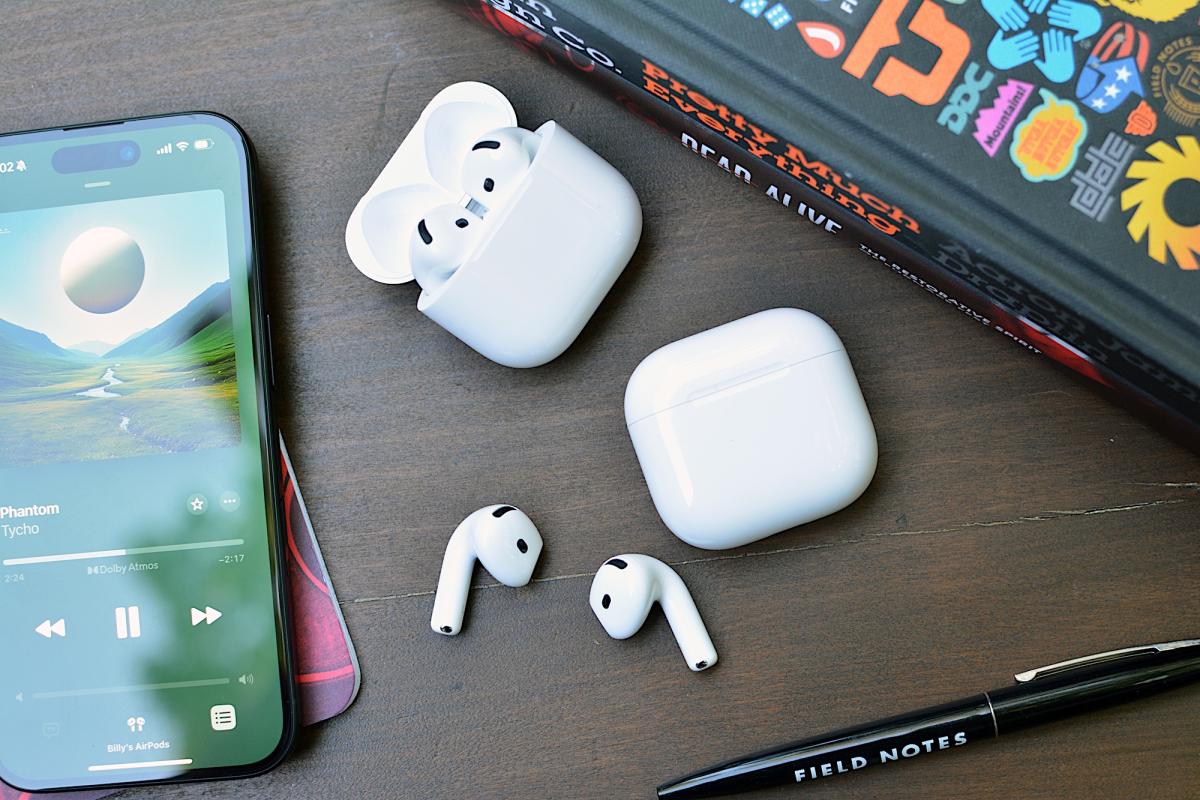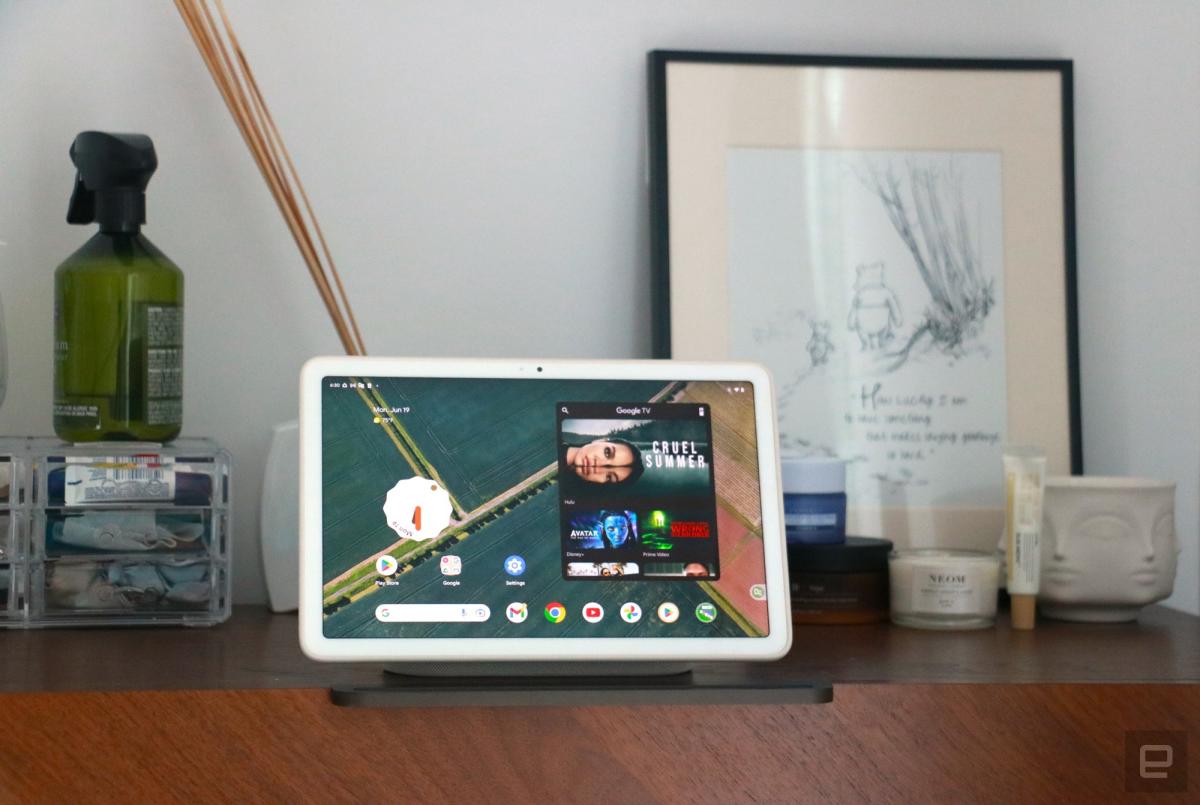With a big redesign to the “regular” AirPods, Apple delivers two new models. Sure, they have a similar look, and share a few features, but the biggest change from the third-gen version is the addition of active noise cancellation (ANC) for an added cost. The AirPods 4 with ANC ($179) option has more to offer in terms of conveniences, but the overhaul has greatly benefitted the AirPods 4 ($129) too. Apple has given its entry-level AirPods extra power, while also offering an option between those and the most expensive earbuds in its arsenal. However, your AirPods choice may still come down to whether you prefer an open-wear design or a fully-closed fit.
Apple offers useful noise cancellation while keeping your ears open on the AirPods 4 with ANC. There are also a lot of Pro features available.
- Improved sound quality
- Better fit
- Effective ANC
- Lots of advanced features
- No onboard volume controls
- Not a great deal when AirPods Pro 2 are regularly on sale
- No hearing protection features
Improved sound quality and the introduction of some advanced features are the key additions on AirPods 4. Plus, the redesigned shape offers a better fit.
- Improved fit and comfort
- Better sound quality
- Advanced features from pricier models
- Still pretty affordable
- No onboard volume controls
- No ANC
- No wireless charging
- No Conversation Awareness
Design
A key difference between the AirPods 4 and Apple’s previous model of “regular” AirPods is the shape of the housing that goes into your ears. The company says it analyzed thousands of ear shapes and over 50 million data points generated by 3D modeling to refine the curves on this new set of buds. Specifically, Apple adjusted the edge of the lower counter and narrowed the overall width for a more secure and more comfortable fit for more people. The company also put the H2 chip in the stem, allowing for a more compact design and improving both airflow and acoustics.
The revised shape does indeed lead to a better fit for my ears. The AirPods 4 are more comfortable and stay in place better than their predecessor. I never once felt like they were going to fall out when I was moving around, unless I turned my head completely to the side to lay down. Open-fit earbuds typically don’t feel the most secure in my ears, but these do, and one less worry contributed to a better overall experience wearing them. Of course, the most secure fit remains with the AirPods Pro.
There’s a force sensor on the stem of the AirPods 4. On both models, you can use that to control music, take calls and summon Siri. Of course, hands-free access to Apple’s assistant is available on both models as well. And on the ANC set, you can long press on the stem to cycle through Noise Control modes (ANC and transparency).
What you won’t find here are onboard volume controls. On the AirPods Pro 2, you can slide your finger on the stem to adjust the level. That function is absent on the AirPods 4. Apple recommends you ask Siri to change the volume, use your iPhone’s buttons, drag the slider on the Lock Screen player or swipe over to the Control Center. There’s also the Digital Crown on the Apple Watch if you’re on the Now Playing screen. Honestly, it’s all a hassle. Siri is too slow and reaching for something that’s not my earbuds just makes me mad. But, that hassle was there on the AirPods 3, so at least Apple is consistent.
Looking at the earbuds themselves, you won’t be able to tell the difference between the two versions of the AirPods 4. You can, however, tell them apart by looking at their cases. The ANC model has a speaker in the case to further assist Find My with beeps, so there are visible holes beside the USB-C port. On both AirPods 4, the LED indicator light is now hidden, so you don’t see an extinguished dot when it’s not on. What’s more, Apple removed the back button for pairing and resetting the earbuds. Now, you’ll double tap near the LED to put the AirPods 4 in pairing mode. And you’ll double tap three times (six taps total) to trigger a reset.
AirPods 4 features
The H2 chip from the AirPods Pro unlocks several notable advanced features on the AirPods 4. Sure, some of those are only available on the ANC model, but there are plenty of handy features on the $129 option. On that new entry-level set, you’ll get Personalized Spatial Audio with dynamic head tracking – immersive listening that’s tailored to your hearing. The sound features also include 48kHz, “cinema-quality” audio for FaceTime and Adaptive EQ. And for calls, Apple’s newly introduced Voice Isolation will offer some extra help when you’re taking calls in less than ideal settings.
The last key piece is Siri Interactions, which allow you to accept or reject calls, respond or dismiss messages and engage or dismiss notifications. All of those are done with a nod or a shake of the head, so you’re free to handle those tasks when you’d rather not speak or can’t reach your phone. And like everything else, you can disable them if you’d rather do things the old fashioned way.
The AirPods 4 with ANC supports all those and then some. For $179, you’ll also get Adaptive Audio, Conversation Awareness, wireless charging and transparency mode. Adaptive Audio comes in handy when you encounter temporary environmental noise, like a coffee grinder or running water, as the tool automatically adjusts sound settings to maintain the overall listening experience. Conversation Awareness lends a hand for quick chats so you don’t have to futz with the earbuds to participate. However, I still wish Apple would fully pause the audio rather than just lowering the volume. I find it distracting, and in some instances I felt I had to talk louder to project over sounds the other person couldn’t hear. (Apologies to my coffee shop barista if I was shouting while I thanked you.)
I’ll also note that transparency mode and ANC go hand in hand, so it’s not surprising that a feature to listen to ambient sound was omitted on the cheaper AirPods 4. And lastly, that case speaker on the ANC version will come in handy for Find My when you inevitably misplace the set. The ANC AirPods 4 case also only supports proximity view in Find My though, not the Precision Finding that AirPods Pro 2 offers.
Of course, there are a few more mainstays from the AirPods lineup that return here. Audio Sharing with someone else wearing Apple or Beats earbuds or headphones is a great feature, as is automatic switching between Apple devices when you get a call or start playing music from your MacBook Pro instead of your iPhone. Both of the AirPods 4 are rated IP54 for moderate dust, sweat and water resistance – just like the AirPods Pro 2. And like that pair, that protection goes for both the earbuds and the case.
Sound quality
Apple equipped the AirPods 4 with a newly designed low-distortion 11mm driver and high dynamic range amplifier. The driver is built with a new membrane mesh as well as a new magnet, and overall, it has higher excursion – or distance the cone can travel. Importantly, Apple is able to offer better acoustic performance by directing the driver straight into the ear rather than positioning it off to the side. By doing this, the company has eliminated sound reflections that impacted overall clarity.
The “richer bass, crisp highs and even more instrument separation” are all claims that hold true when compared to AirPods 3. There’s more low-end tone than the previous model right out of the gate, and the punchier treble opens the sound stage so it’s wider and more immersive. The improved frequency response is on full display with Dolby Atmos content (movies, music and TV), but the AirPods 4 are also more sonically adept with non-spatial tunes and video.
That promised instrument separation is apparent on Tycho’s synth-laden Infinite Health. Rather than seeming smashed together, the synths are all layered, reproducing the atmospheric soundscape the artist intended. Billy Strings’ Live Vol. 1 isn’t an Atmos album, but the AirPods 4 do an excellent job with the finer details of the live recordings. You get the reverb of the PA system, warmth of the upright bass and the subtle percussion in the bluegrass picking. The acoustic instruments stand on their own, with plenty of character studio tracks don’t offer. And for bass-heavy styles, like Kaytrana’s Timeless, the AirPods 4 have pleasant, thumping low-end that doesn’t overpower. Vocals still cut through the mix, as does the rest of the electronic/hip-hop instrumentation.
Audio performance is consistent on both sets of AirPods 4. Like I already mentioned, both are equipped with Personalized Spatial Audio with dynamic head tracking and Adaptive EQ. So, in terms of base sound performance, there are no sonic sacrifices between the two.
ANC performance on the AirPods 4
Active noise cancellation on open-design earbuds is usually minimally effective. It’s very difficult for the technology to provide the kind of relief from distractions you likely crave when your ears aren’t sealed off with an ear tip. Apple isn’t the first company to try this, but I’d argue it is the first to offer a solution that actually makes a difference.
Apple employs the H2 chip and the same ultra-low-noise microphones from the AirPods Pro 2 to power the ANC setup on the AirPods 4. The primary goal is to reduce low-frequency noise, which means you’ll notice the most impact on things like airplane cabin hum, HVAC systems and city traffic. The company promises you’ll be able to listen to music and other media at lower volumes on the ANC model without distraction or sacrifices to audio quality, all thanks to this system.
It’s not the world-blocking magic that Sony’s WF-1000XM5 and other devices that seal off your ears offer, and it’s not nearly as good as the AirPods Pro 2 either. But, for earbuds with an open-wear design, the difference when ANC is enabled is actually noticeable. The AirPods 4 struggle with TV noise and human voices, but they do well with constant, low rumbling distractions. On similar models I’ve tested from other companies, active noise cancellation made little to no difference, and only served to drain the battery faster. If you’re looking for something close to silence, the AirPods 4 won’t give you that. However, the earbuds will deliver a noise reduction that will put a dent in raucous environments, and do so most effectively with low-frequency sounds.
Call quality
AirPods are popular options for hands-free calls, so Apple has improved how you sound when taking voice and video calls. Voice Isolation is an H2-powered tool that Apple says “isolates and enhances your voice,” and is a new feature for the AirPods 4 and AirPods Pro 2. Essentially, it removes background noise to keep you sounding your best when you’re in loud environments.
With compatible AirPods, like the fourth-gen model, Voice Isolation is enabled by default for calls and FaceTime video, but you can turn it off in microphone settings on iOS, iPad and Mac. The feature also works with any third-party apps that use CallKit, like WebEx, Zoom, WhatsApp and more. Like the ANC, this is another impressive feat from Apple. Voice Isolation totally negates raucous fans, running water and other would-be distractions for the person on the other end. I did notice a very slight difference in overall voice quality, but it’s a fair trade-off for sounding like you’re in a silent room when you’re not.
The AirPods 4 with ANC also have transparency mode, which is helpful for calls. This noise control setting pipes in the most natural ambient sound of any earbuds, just like the AirPods Pro 2.
AirPods 4 battery life
Apple says you can expect five hours of battery life on both versions of the AirPods 4. With ANC active on the pricier model, you’ll get one hour less of play time. Both of the AirPods 4 offer five charges in the case, which brings total usable time to 30 hours. Apple explains that all of its stated battery figures are at 50 percent volume with Spatial Audio off. For the ANC version, the company says the estimates also include disabling Conversation Awareness.
50 percent volume won’t be loud enough for most people on iOS, so I conducted my tests at around 70 percent there. Around 50 percent is good enough on Mac, though. Using a combination of those two settings across the devices, and employing a mix of both ANC and transparency mode while playing spatial audio and regular content, I got four hours out of the noise-canceling AirPods 4 with no problem. I had no issues hitting the stated figure on the non-ANC version either.
As a reminder, only the ANC version supports wireless charging. While that case will work with Apple Watch chargers, it doesn’t support MagSafe accessories. If you find yourself in a pinch, both sets of AirPods 4 can offer an hour of use in five minutes.
The competition
Apple’s main competition for the AirPods 4 is the company’s other earbuds. The likes of Sony don’t offer the deep iOS and macOS integration, which is a key selling point for any AirPods. That being said, the AirPods Pro 2 is the only other consideration if you’re looking for another flavor of AirPods. The earbuds are two years old at this point, but the company is still adding new features. For example, AirPods Pro 2 is getting Voice Isolation and Siri Interaction today when iOS 18 drops. More importantly, Apple just got FDA approval for its Hearing Aid feature that will arrive alongside a Hearing Test tool this fall. Expanded Hearing Protection items are on the way as well.
Of course, you’ll get enhanced noise cancellation (with an ear tip seal) on AirPods Pro 2, and a transparency mode that handles your voice better. There’s also two more hours of battery life over the ANC AirPods 4, a MagSafe-compatible case, Find My Precision Finding and, crucially, on-board volume controls. The second-gen AirPods Pro are available for $190 right now, and we’ve seen them dip to $180 over the summer. If you can find them for the same price as the more expensive AirPods 4, you might want to go that route. I don’t expect Apple will have a replacement before September 2025, so you don’t have to worry about them becoming immediately obsolete if there’s another hardware event next month or early next year.
Wrap-up
With the noise-canceling AirPods 4, Apple has bridged the gap between the entry level model and the AirPods Pro. The ANC version gets nearly all of what makes the AirPods Pro 2 so good, except for the most powerful noise cancellation, the upcoming hearing health features and a few other items. However, a $179 set of AirPods isn’t a great deal right now with the AirPods Pro 2 available for nearly the same price if you catch them on sale. The $129 AirPods 4 is a big improvement over the previous version though, and they’re a worthwhile update for fans of the basic, non-ANC formula. The question then becomes if you prefer the open design and can live without the Pro’s extras. Both versions of the AirPods 4 have their merits, but for once, price won’t be a deciding factor when choosing between two Apple products.



